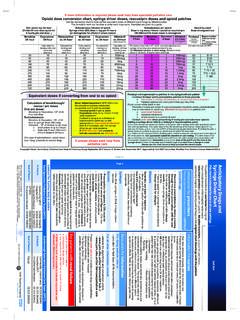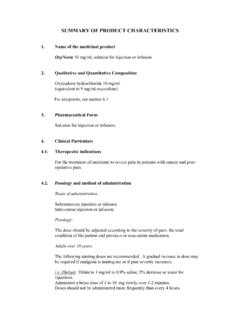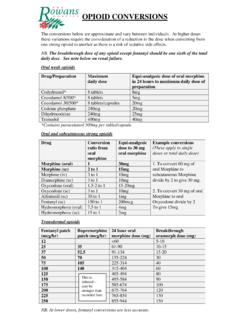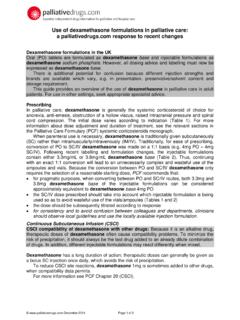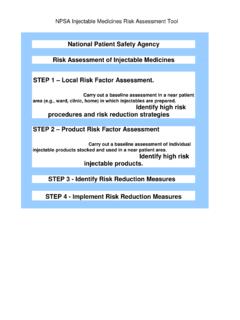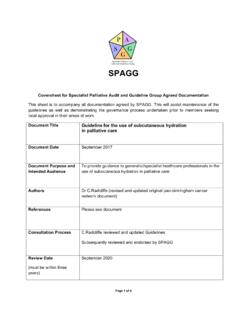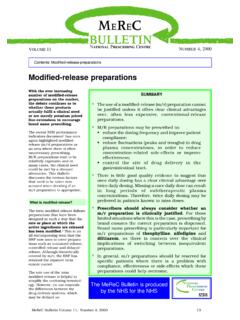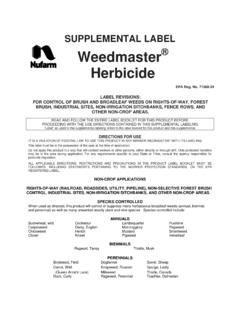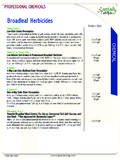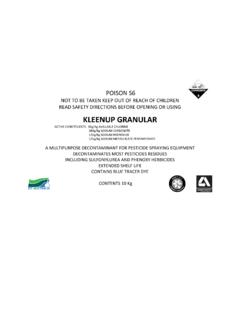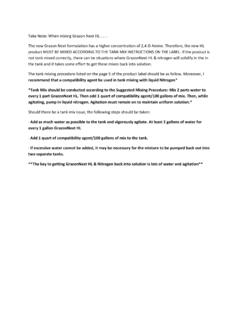Transcription of Guidelines for Ketamine Use - © palliativedrugs.com
1 St Joseph's Mercy Hospice Auckland NZ Guidelines for Ketamine Use Ketamine is a dissociative anaesthetic agent which has analgesic properties in sub-anaesthetic doses 1 Its principal site of action is in the dorsal horn of the spinal cord where it blocks the N-methyl D-aspartate (NMDA) receptor complex. Ketamine is used in palliative care settings primarily for neuropathic pain which is unresponsive or poorly responsive to first-line analgesics (which may include one or more of opioid drug, NSAID, tricyclic antidepressant, or anticonvusant) It has also been used for phantom limb and ischaemic pain and for intractable incident pain or prior to procedures such as dressing changes.
2 Potential side effects Ketamine Routine use of Ketamine is limited by its cost and potential side effects which may occur in up to 40% of patients; These may include: Psychotomimetic phenomena feeling strange - dysphoria, vivid dreams, nightmares, hallucinations, altered body image. These effects may be minimised or treated by concurrent use of haloperidol or a benzodiazepine Delirium Hypertension, tachycardia Diplopia, nystagmus Erythema and pain at injection site Contraindications to Ketamine use Ketamine has the potential to increase intra-cranial and intra-ocular pressures.
3 It is contraindicated in patients with a history of hypertension, cerebrovascular disease or epilepsy and should be used with caution in patients with raised intra-cranial pressure and/or known cerebral metastases. Dosage regimens for Ketamine use 1. Burst Ketamine 2 Ketamine is prescribed as a burst or pulse course for a maximum of 5 days. The dose is titrated up, in a stepwise fashion, and once the lowest effective dose is achieved it is continued for 3 days at that dose then stopped. This method has the advantages of an adequate trial of treatment (with discontinuation if analgesia is ineffective or significant side effects occur) and minimisation of the logistics of longer term Ketamine use.
4 (cost, syringe driver monitoring and sc site irritation) Burst Ketamine protocol Starting dose 100 mg per 24 hrs via syringe driver If effective continue for three days then cease If 100 mg ineffective after 24 hrs, increase to 300 mg If 300 mg effective, continue three days then cease If 300 mg ineffective after a further 24 hrs increase to 500 mg Cease Ketamine at day 5 whether effective or not, or earlier if significant side effects occur See appendix for protocol sheet to include in drug chart 1 Fallon MT and Welsh J.
5 The role of Ketamine in pain control. European Journal of Palliative Care, 1996;3: 143- 146 2 Jackson K et al. Burst Ketamine for refractory cancer pain: An open label audit of 39 patients. J Pain and Symptom Management 2001;22:834-842 2. Continuous Subcutaneous Ketamine 3 Starting dose 1 mg/kg per 24 hrs Increase by 50 100 mg per 24 hrs. Maximum reported dose G /24 hrs Duration of administration determined by clinical response 3 PRN Ketamine for incident pain or prior to procedures 3 10 25 mg sc prn ( mg per Kg approx) 4. Oral Ketamine 3 May be used directly from the vial or diluted to 50 mg /5 ml with flavour of choice added Starting dose 10 25 mg tds qid and prn Increase dose in steps of 10 mg up to 50 mg qid Maximum reported dose 200 mg qid Use a smaller dose more frequently if psychotomimetic phenomena or drowsiness occurs which does not respond to a reduction in opioid dose (see below) Concurrent opioid use 4 The current dose of opioid may need to be reduced when starting Ketamine or if excessive drowsiness or psychotomimetic phenomena occur.
6 If opioid dose is stable with minimal breakthrough requirements, consider reducing the opioid dose by 25 50% If pain is unstable and frequent breakthrough analgesia is required, consider reducing the opioid dose by 10% Reassess opioid and Ketamine dose every 24 hrs Note if Ketamine is used with methadone, be alert to the possibility of opioid toxicity developing over several days as a consequence of the long and variable half-life of methadone. Minimising side effects 3 If patients develop psychotomimetic phenomena, consider concurrent use of haloperidol ( mg bd) or benzodiazepine (clonazepam 1 mg nocte; midazolam 5 mg stat and 10 15 mg per 24 hrs via syringe driver) In patients at risk of dysphoria, the above may be started prior to the Ketamine infusion Erythema and pain at injection site dilute with normal saline in 20 or 30 ml syringe Use with other medications 3 Ketamine is miscible with morphine, haloperidol, metoclopramide , levomepromazine, midazolam and low dose dexamethasone.
7 It should be diluted with nosrmal saline. Addition of 1 mg of dexamethasone may reduce sc site inflamation 3 * Ketamine 4 bulletin board discussion 06/01/05 to 13/01/05 Appendix To be placed in drug chart of patients prescribed Burst Ketamine Burst Ketamine dose escalation protocol Starting dose 100 mg per 24 hrs via syringe driver If effective continue 3 days then cease 100mg 100mg 100mg Stop 0 1 2 3 If 100 mg ineffective after 24 hrs, increase to 300 mg If 300 mg effective, continue three days then cease 100mg 300mg 300mg 300mg Stop 0 1 2 3 4 If 300 mg ineffective after 24 hrs increase to 500 mg 100mg 300mg 500mg 500mg 500mg Stop 0 1 2 3 4 5 Cease Ketamine at day 5 whether effective or not, or earlier if ineffective and/or significant side effects Potential side effects of Ketamine Routine use of Ketamine is limited by potential side effects which may occur in up to 40% of patients.
8 These may include: Psychotomimetic phenomena feeling strange - dysphoria, vivid dreams, nightmares, hallucinations, altered body image. (see below) Delirium Hypertension, tachycardia Diplopia, nystagmus Erythema and pain at injection site dilute with normal saline in 20 or 30 ml syringe Minimising side effects If patients develop psychotomimetic phenomena, consider concurrent use of haloperidol ( mg bd) or benzodiazepine (clonazepam 1 mg nocte; midazolam 5 mg stat and 10 15 mg per 24 hrs via syringe driver) In patients at risk of dysphoria, the above may be started prior to the Ketamine infusion Concurrent opioid use be alert to the possibility of opioid toxicity developing over several days and consider opioid dose reduction.
9 (see guideline) Contraindications to Ketamine use Ketamine has the potential to increase intra-cranial and intra-ocular pressures. It is contraindicated in patients with a history of hypertension, cerebrovascular disease and epilepsy and should be used with caution in patients with raised intra-cranial pressure and/or known cerebral metastases Ref: Jackson K et al. Burst Ketamine for refractory cancer pain: An open label audit of 39 patients. J Pain and Symptom Management 2001;22:834-842
